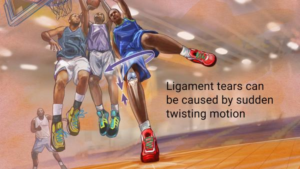ACL tears are commonly repaired in athletes. Interestingly, a good study noted that a second ACL injury rate was 15% (8% on the surgery side, 7% to the opposite side). Patients younger than 25 years had a second ACL injury rate of 21%. Athletes younger than 25 years who returned to sports had a second ACL injury rate of 23%.
A systematic review and meta-analysis (good research) reported the overall ACL injury incidence rate to be 0.062 injuries per 1000 exposures in US high school athletes. Compared to boys, girls had a relative risk rate of 1.57 injuries per exposure, despite a greater number of ACL injuries in boys. In girls, the highest per-season injury risk levels (incidence rate by number of exposures per season) were seen in soccer (1.11%), basketball (0.88%), and lacrosse (0.53%). In boys, the highest injury risk levels per season were seen in American football (0.80%), lacrosse (0.44%), and soccer (0.30%).
High level evidence notes neuromuscular electrical stimulation should be used for 6 to 8 weeks to augment muscle strengthening exercises in patients after ACL reconstruction to increase quadriceps muscle strength and enhance short-term functional outcomes. We use this at McVay PT.
Balance was shown to be affected in the surgical knee in anther study. The authors found that static postural control (single-leg stance on fixed platform with eyes open and closed) was moderately impaired after ACL reconstruction compared to healthy controls, and moderately magnified with dynamic postural control tasks (eyes open on unstable platforms or perturbations).
Approximately 80,000 to 250,000 injuries occur to the anterior cruciate ligament (ACL) per year in the United States, with about 100,000 ACL reconstructions performed annually, the sixth most common orthopaedic procedure in the United States. Approximately 70% of all ACL injuries are noncontact in nature and 30% are contact injuries. The incidence of posterior cruciate ligament (PCL) injury is 0.65% to 44% of all ligamentous knee injuries. The most common causes for PCL injury are motor vehicle accidents and athletics. The incidence of MCL tears is 7.9% of all athletic injuries. Injury to the LCL is the least common of all knee ligament injuries, with an incidence of 4%. Two of the most common multiligament knee injuries involve the MCL and the ACL, and the posterolateral corner (PLC) and the ACL or the PCL.
Another study compared sex differences of knee laxity (looseness) after ACL reconstruction based on repair type. Women had greater front to back knee laxity after hamstrings graft ACL reconstruction compared to women after bone-patellar tendon-bone graft reconstruction and to men after ACL reconstruction with either graft. However, no very high level studies were available for analysis.
Return to sport: 81% of athletes were able to return to some level of sport, 65% of athletes returned to their preinjury sport level, and 55% of athletes returned to competitive sport. Side to side symmetry with hop performance, younger age, male sex, and risk appraisal increased the odds of returning to preinjury sport. Interestingly, athletes with bone-patellar tendon-bone autografts had greater odds of returning to preinjury sports, whereas athletes with hamstrings autografts had greater odds of returning to competitive sports, although most of the studies included in this comparison were not randomized trials.
Data sourced from JOSPT: http://www.jospt.org/doi/full/10.2519/jospt.2017.0303




Recent Comments